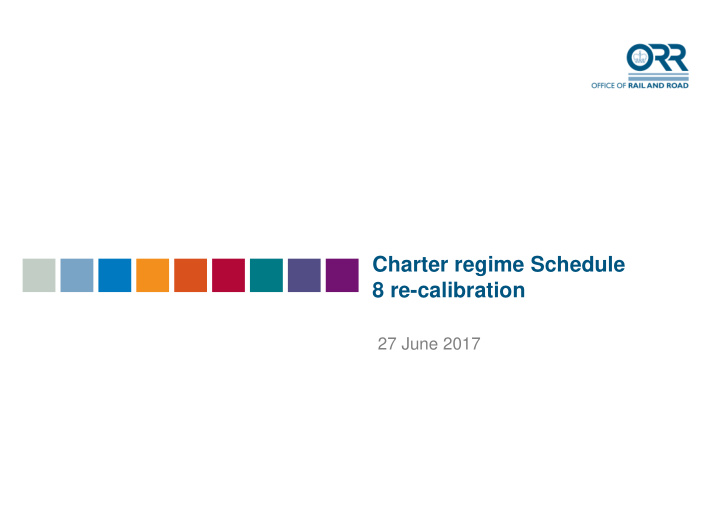



Charter regime Schedule 8 re-calibration 27 June 2017
2 Charter Schedule 8 regime ■ Today we will discuss the approach to re-calibrating the following aspects of the Schedule 8 regime for charter operators: Network Rail Charter operators Payment rate Payment rate Benchmark Benchmark Annual caps Incident caps Annual caps
3 Payment rates
4 Network Rail payment rate ■ Current approach to setting Network Rail payment rate – The Network Rail payment rate in the charter Schedule 8 regime is set equal to Network Rail payment in the freight regime. – It is the same for all charter operators. ■ Pros and cons of using Network Rail payment from the freight regime Low cost and simple to use given the alternative would involve collecting data and evidence. × The Network Rail payment rate from the freight regime may not accurately reflect the impact of delay on charter operators’ costs and revenues. ■ What are we proposing? – For discussion: Continue to use Network Rail payment rate from the freight regime as the basis for the Network Rail payment rate in the charter regime. – Alternatively charter operators can collect evidence to set a specific Network Rail payment rate for the charter regime, any evidence used would have to be approved by ORR – although this work would need to be completed quickly.
5 Charter operator payment rates ■ Current approach to setting charter operator payments rate – Charter operators have a specific payment rate based on the Network Rail payment rates for passenger operators weighted by the amount of third party charter operator delay affecting each service group. ■ What are we proposing? – For discussion: Continue to use the current methodology to set a specific charter operator payment rate. ■ Industry involvement in the recalibration of payment rate – Work on the passenger operator payment rates has yet to start. – We suggest that charter operators could be updated on this work at the same time as freight operators, through whatever group is used for the freight re-calibration.
6 Benchmarks
7 Network Rail benchmark ■ Current approach to setting the Network Rail benchmark – Network Rail’s benchmark is set on the basis of its own past performance in relation to charter operators. ■ What are we proposing? – For discussion: We suggest keeping current methodology
8 Charter operator benchmark (1) ■ Current approach to setting the charter operator benchmark – The charter operator benchmark is set based on the average performance across all charter operators. – The charter operator benchmark is adjusted each year (using the formula below) to reflect actual traffic growth or reduction. × [( Adjusted = × )+1] Current charter Congestion charter Traffic growth benchmark factor benchmark Reflects how increased traffic on the Annual percentage Delay minutes per network will increase delay to other change in total train 100 train miles operators when a charter operator delays miles run on the network other trains ■ Illustrative example for year 2 of CP5 (based on actual traffic levels in the previous year) × [( × 5.82 delay = 5.86 delay )+1] minutes per 100 minutes per 100 1.044 0.63% charter charter operator miles operator miles
9 Charter operator benchmark (2) ■ What are we proposing? – For discussion: Continue to set a single charter operator benchmark on the basis of average charter operator performance. – On the congestion factor: • ORR will decide what will happen on congestion factor owing to its dependence on the capacity charge modelling.
10 Annual caps and incident caps
11 Annual caps ■ Current approach to annual caps – All charter operators and Network Rail have same annual cap and it is the same as the default annual cap for ‘small’ freight operators. – The annual cap in the charter operator Schedule 8 regime is £547,000 ■ What are we proposing? – For discussion: Continue to use the default annual cap for ‘small’ freight operators as the annual cap in the charter regime. – We expect Network Rail will be re-calibrating costs of providing caps.
12 Incident caps ■ Current approach to incident caps – An incident cap menu with associated Access Charge Supplements (ACSs) was introduced in CP5 allowing charter operators to choose the maximum amount they pay in a single incident. ■ What are we proposing? – For discussion: We are proposing to keep the existing regime although we expect ACSs to be updated to reflect cost of risk to which Network Rail is exposed.
13 Next steps
14 Next steps ■ Given the close relationship with the freight operator regime, we suggest that charter operators may wish to be involved in any on- going freight re-calibration working group. ■ Alternatively charter operators may wish to work independently with Network Rail on the re-calibration of the regime.
Recommend
More recommend